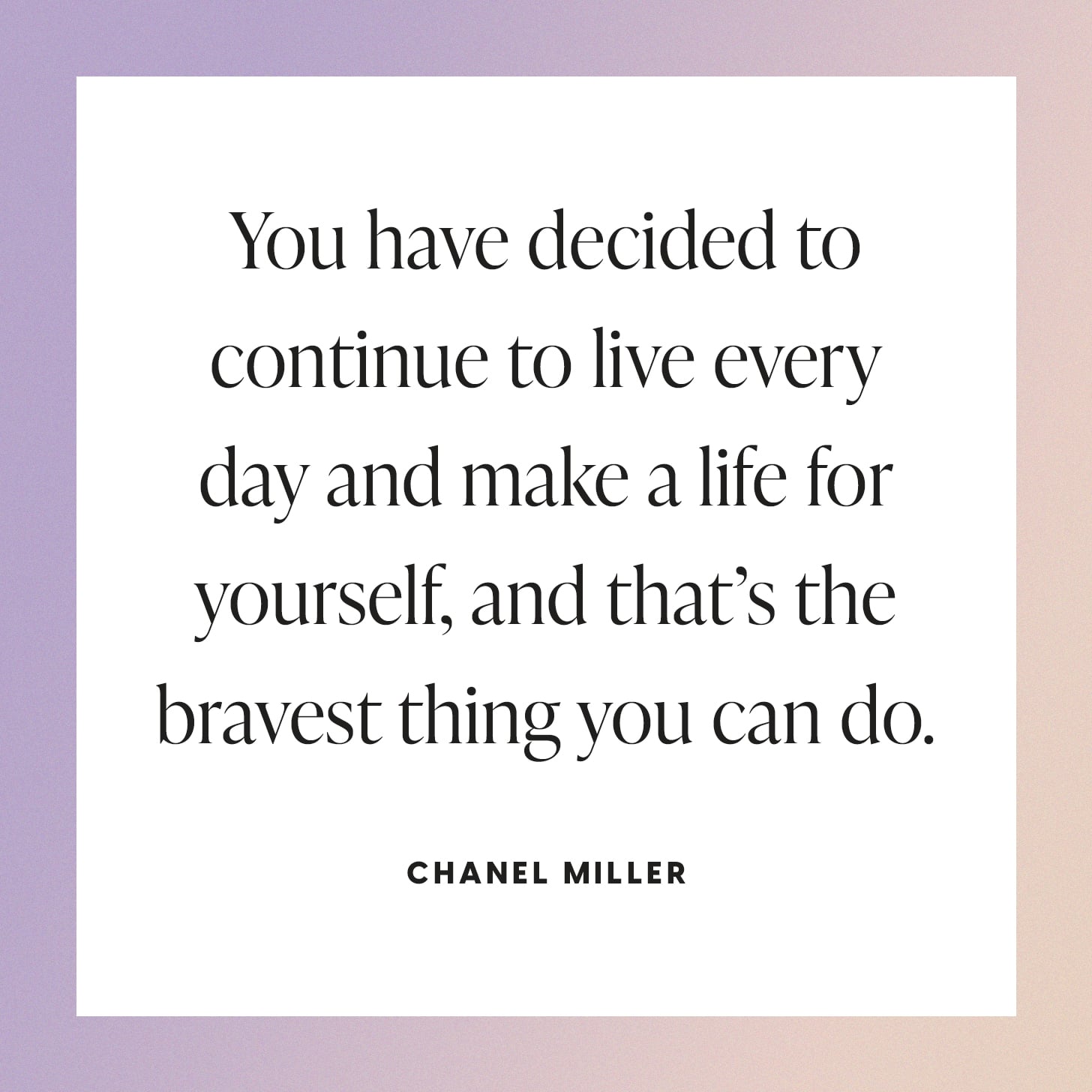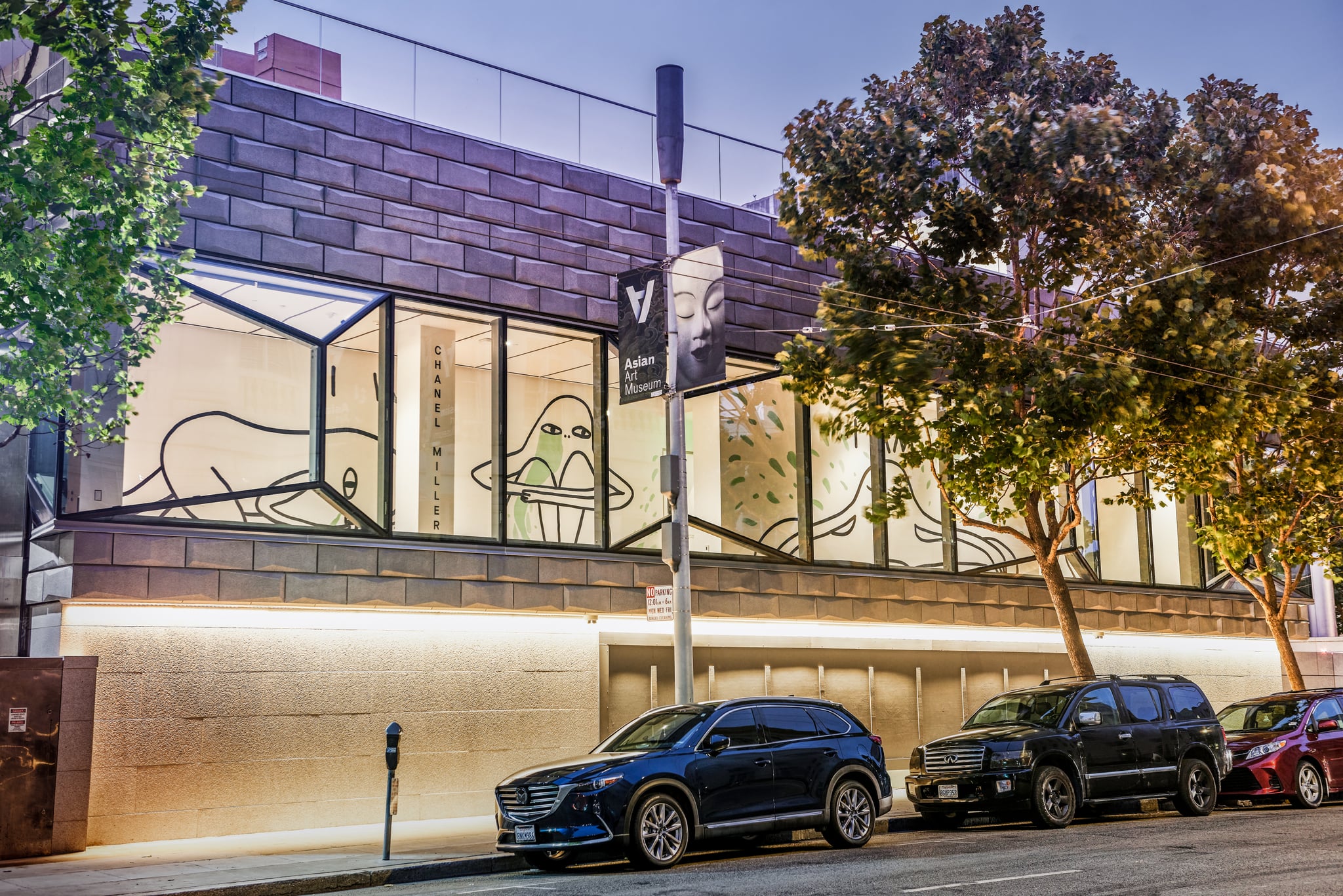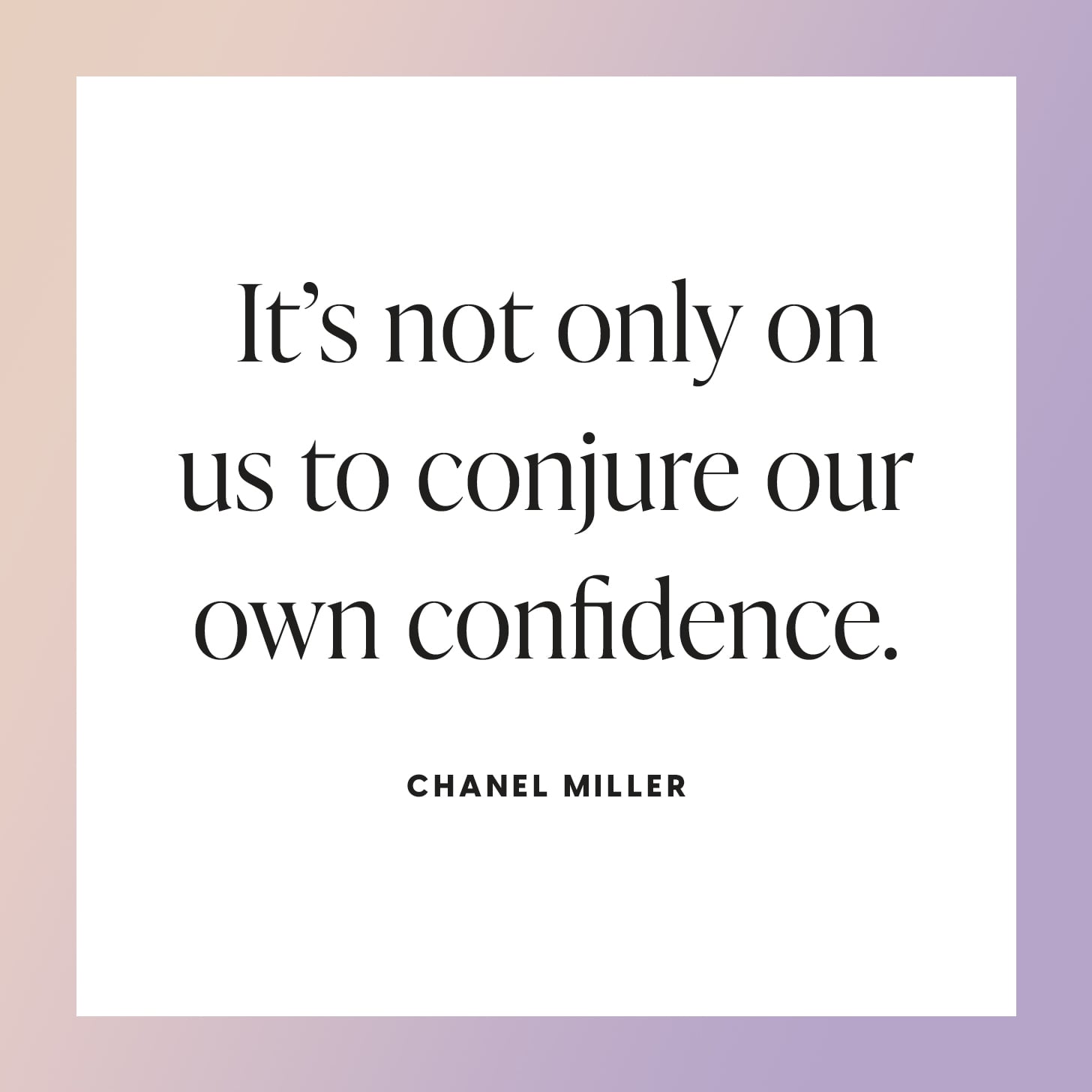Image Source: Maria Tiffany and Photo Illustration: Becky Jiras
I hesitate to start this story in the past, but I think it helps us fully savor the present.
Five years ago, Chanel Miller was working on her memoir, “Know My Name,” in secret. She was 25 and living in San Francisco, spending every day up against the monumental task of rehashing her trauma and putting it into words.
The world knew her then as Emily Doe, the victim in a 2015 Stanford sexual-assault case that had come to define the issue of rape on campus. Miller hadn’t yet decided whether she would publish her memoir anonymously; most of her friends didn’t even know she was the victim in the case. Her life was split in two: Emily in the courtroom and the headlines, Chanel out in the world, holding onto a weighty secret.
“I couldn’t fathom coming forward, and I also couldn’t fathom continuing my life in the isolation that I was experiencing writing,” Miller, now 30, remembers carefully over Zoom, her eyes darkening. She’s sitting in her white-walled New York City apartment, a rainbow stack of books piled behind her. “There were many days where I thought no path exists, so just give up now.”
Then, something pivotal happened. In the fall of 2017, allegations against Hollywood producer Harvey Weinstein set off the #MeToo movement, and stories of sexual harassment and assault reverberated across the world. It had roots in the antirape activism led by women of color for centuries, and it was a direct continuation of the movement Tarana Burke had started a decade before. It also mirrored what happened when BuzzFeed anonymously published Miller’s own victim impact statement in 2016.
These watershed moments were beautifully interwoven: each one both influenced by and influencing others, each an affirmation of a larger, indelible truth. For so many years, people had been shamed and coerced into keeping sexual violence a secret. But now they were speaking, and being heard.
All of this momentum influenced Miller’s decision to come forward with her identity and publish “Know My Name” as herself in 2019, joining both identities into one. The book — an indicting portrait of what it means to live as a survivor in America — would go on to become a New York Times bestseller. Miller would appear on “The Daily Show” and podcasts, her advocacy treasured. She’d become famous for her art, too, which would feature in the pages of The New Yorker and the halls of the Asian Art Museum in San Francisco.
I’ve asked Miller to revisit this sequence of events on a sleepy weekday in October because it’s the five-year anniversary of #MeToo — a moment in and of itself worthy of reflection. But we’re not here to analyze the material gains or losses of the movement. We’re here, starting in the past, to explore what five years of healing can mean for any survivor.
“We are joining in this chorus and each trying to put a piece of ourselves down, and kind of seeking the comfort of the collective pieces and making sense of what it means for society,” Miller says. “But rarely are we asked, ‘What else do you want to do? What else do you want to say?'”
 Photo Illustration: Becky Jiras
Photo Illustration: Becky Jiras
When Miller moved to New York at the beginning of 2020, just months after publishing her memoir, she stuck a little Post-it Note to her door to remind herself daily: “You are a writer in New York City.”
“It’s inconceivable that I would’ve lived out that sentence,” she says. “Like, that’s the dream. And it’s not ordinary — well, it’s beautiful because now it is ordinary, but it’s so important to take these moments to remember how inconceivable my reality is for that self in 2017.”
I’d been in New York City, too, when I first encountered Miller’s work. It was 2016, the summer before my senior year of college, a brief lease on adulthood. I didn’t know that it was Miller who had written the words, but it didn’t matter. When I started reading her anonymous victim impact statement — sent to me in a group chat with close friends — my throat caught; the subway car went blurry. I’d never read anything quite like it. The writing felt so sacred that I clicked off my phone and saved it for later, to read when I was all alone.
Although it was groundbreaking to me at the time, Miller’s statement was an important part of a much longer legacy of antirape activism, according to Meenakshi Gigi Durham, a University of Iowa professor and author of “MeToo: The Impact of Rape Culture in the Media.” That included movements like Take Back the Night, which reached back to the 1970s, and Burke’s activism, which centered Black women in the 2000s.
One of the most “enduring legacies” of Miller’s case and her victim impact statement, Durham tells me, is that it “helped create common language” around this deeply ingrained issue. It was proof that speaking out mattered.
And in this way, it presaged all that was to come a year later, when The New York Times and The New Yorker published the allegations against Weinstein, setting off another cascade of stories. Miller’s anonymous statement would also factor into Dr. Christine Blasey Ford’s decision to testify against Supreme Court Justice Brett M. Kavanaugh in 2018 — testimony that, in turn, would finally convince Miller to come forward with her real name a year later.
Miller’s case was unique in that it was both a paragon and an exception. On the one hand, it reflected the inequities inherent in the criminal justice system, in which a white male judge gave a stunningly light sentence to a white male college student who was convicted of raping a young Asian American woman. And on the other, it was a rarity in that it ended in a conviction at all. According to RAINN, more than two out of three rapes go unreported, and less than one percent of rapes lead to felony convictions. Meanwhile, one out of six American women has been the victim of an attempted or completed rape in her lifetime, a statistic that is higher for women of color, and Black women specifically.
When Miller talks about her case now, she’ll sometimes slip into the second person, addressing you directly: a collective you. It’s clear when she does this that there’s still so much more she wants to communicate to survivors — most pressingly that she sees the aftermath of her assault as the exception, not the rule.
“I want you to see how much had to be in place for me to succeed, how many people had to constantly encourage me to continue at multiple times when I would’ve rather given up,” she tells you.
“Our courage can only get us so far, and what we need is people who will be there through the long haul and who will not abandon us at our lowest lows,” she continues. “So it’s never about, ‘Oh, I just wasn’t brave enough.’ You are very brave . . . you have decided to continue to live every day and make a life for yourself, and that’s the bravest thing you can do.”
A day before I’m set to interview Miller, I hop on a city bus and head to the Asian Art Museum in downtown San Francisco. The fog has just lifted from the city; gray turns to gold through the windows.
The bus turns a corner, I look up, and there it is: Miller’s name printed cleanly on a white pillar behind glass. On a massive wall behind the pillar, three characters stare down at me, transforming from past, to present, to future. The past self is curled up in a ball, crying; the present self is grounded in a seated position; and the future self is rising, confidently, and walking out of the piece of art. “I was, I am, I will be.”
 Image Source: Asian Art Museum
Image Source: Asian Art Museum
The mural is stunningly large in person, which is fitting given that it was Miller’s next major project after publishing her memoir. When the Asian Art Museum approached Miller in 2019 and asked her to create something for this 70-foot blank canvas, she was surprised at the scale of it, too. But she understood that the museum’s directors trusted her to create something resonant and fitting of its scale. It taught her an important lesson about her worth as an artist, Miller says.
“It’s not only on us to conjure our own confidence,” she explains. “It’s really important for people to create that space and say, ‘This is yours, even if we don’t know what the end product will look like yet.'”
It was a different story when Miller started working on her memoir in early 2017. The remembering of her trauma and the writing itself weren’t the biggest challenges, she says — instead, it was being convinced of her own worth: “The hardest part was understanding why I could be important enough to ask someone to be in my life for over 300 pages.”
Part of that, she adds, was because she hadn’t read many Asian American authors in her classrooms growing up. As she writes in her memoir, the experience of being Chinese American in a predominantly white community (not to mention a country that didn’t exalt Asian artists and writers) had influenced her self-perception: “It did not feel possible that I could be the protagonist.”
When the memoir was published, it was deeply meaningful — for me and other Asian American women especially — to see Miller claim her name and her space. So much of the coverage early on during #MeToo elevated the voices of famous white women. When Miller came forward with her identity in 2019, she didn’t just broaden our idea of what a strong survivor could look like; she actively tore down stereotypes. And through the lens of Miller as protagonist, we learned just how hard she had to fight within a system meant to keep us small and silent.
The significance that her next large-scale work was commissioned by the Asian Art Museum doesn’t elude me, or her, now. “That’s something the museum did for me: it helped me think about how else I wanted to communicate in the world,” Miller says.
 Image Source: Asian Art Museum and Photo Illustration: Becky Jiras
Image Source: Asian Art Museum and Photo Illustration: Becky Jiras
And looking at the mural itself — the way it so literally takes up space to illustrate the past, the present, and the future — I realize that art is always in conversation with where we’ve been, and where we are, and where we’re going. Miller’s work resonates, I think, because she is unafraid to take us on this journey with her.
These days, Miller says that while she takes moments “to marvel” at how far she’s come, she also honors the difficult work she has put into forging this previously nonexistent path.
“It’s also like, yeah, this is my life,” she says, decidedly. “And it’ll be my life in five years, and in 10 years, I’ll be creating even more in different mediums.”
 Photo Illustration: Becky Jiras
Photo Illustration: Becky Jiras
It’s not until about three-quarters through our interview that the mood really shifts. We’ve talked about the memoir and the mural, and I’ve just asked a simple question — “What are you creating these days?” — when, all of a sudden, Miller’s face brightens. It’s as if a great orb is lighting up her face.
“It’s an illustrated, middle-school-grade chapter book,” she says, her smile going wide.
We both start cooing with excitement. I realize that for someone whose work for so long has revolved around trauma, a project like this must feel inexplicably freeing. You can see it in the way her shoulders relax down, how she’s clapping her hands together as she talks about it. She’s writing this book for the kids she passes by in the park and on the subway, she tells me, all in their own little worlds.
“A part of me is like, is this illegal to be experiencing this much joy for your full-time job?” she says, laughing. “Like, my ‘problems’ are plot points. . . . Am I allowed to have this life?”
The answer is: of course she is. But that joking question is a reminder of what we, as women, have been told in so many ways and for so long. It’s why, even amid all the lightness, Miller acknowledges the weight this next book carries.
“Even though it is totally disconnected and has nothing to do with sexual assault, I hope that in my pursuing it, survivors will — it’ll help free them to pursue other things, too,” she says.
I get the sense that Miller does this quite a bit in her everyday conversations, outside of her art and writing — draws deeper meaning from what’s happening in real time. She tells me about one recent example: On a fall day in New York, Miller was sitting outside alone at a cafe when a stranger approached her. The stranger introduced herself as Rachel and said she was moved by Miller’s memoir. The two had a lovely conversation, and then Rachel went back to her table.
When Rachel got up to leave, she stopped by Miller’s table one last time and left a box. Miller gingerly opened it; inside was a piece of cake.
Before that conversation, Miller had been totally isolated, deep in her own thoughts. “Now I look at my table, and there’s this beautiful cake that seems like it has materialized out of nowhere,” she says. “I know it’s from this wonderful woman named Rachel, but I’m also thinking, ‘Where did this come from? What was happening — what connection was being made that I didn’t even know about when she was reading the book?'”
Before I can wonder out loud, Miller answers her own question: “There was something out in the universe being generated; there was some friction stewing that I wasn’t even aware of. And now it has materialized in the form of a cake.”
She smiles again, widely. And for a long while after our conversation, I think of the piece of cake — the way five years of pain and path-forging can give way to connection; to sweetness; to joy. I think of how satisfying it must feel to take a bite.
Read more stories about the five-year anniversary of #MeToo:

